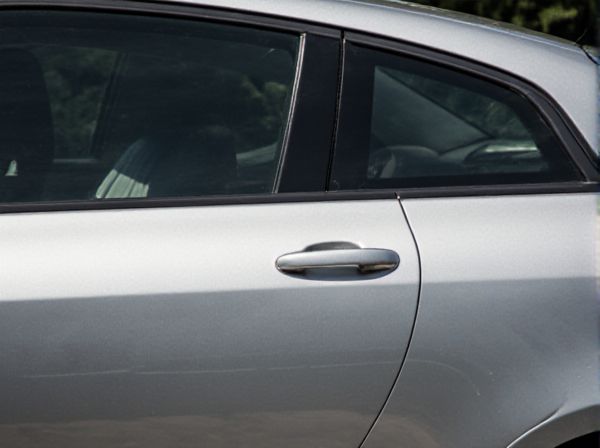
Photo illustration: Suicide vs Conventional Door
Suicide doors, hinged at the rear, offer easier access to the vehicle's interior and a unique design that enhances style and functionality, especially in tight parking spaces. Conventional doors, hinged at the front, provide a more traditional and secure closure, widely preferred for their simplicity and familiarity. Choosing between suicide and conventional doors depends on your preference for aesthetics, convenience, and safety.
Table of Comparison
| Feature | Suicide Door | Conventional Door |
|---|---|---|
| Hinge Position | Rear-hinged | Front-hinged |
| Ease of Access | Better rear seat access | Standard access |
| Safety | Higher risk if door opens while moving | Safer, less likely to open by accident |
| Design | Classic, stylish appeal | Common and practical |
| Usage | Rare, luxury, or vintage cars | Standard in modern vehicles |
| Installation Cost | Higher due to complexity | Lower, mass-produced |
Introduction: Understanding Suicide Doors vs. Conventional Doors
Suicide doors, hinged at the rear rather than the front like conventional doors, offer unique accessibility and style features often favored in classic and luxury vehicles. These doors provide easier entry and exit in tight spaces, enhancing passenger convenience and aesthetic appeal. Understanding the structural and safety differences between suicide and conventional doors is essential for making informed automotive design and purchase decisions.
Historical Background of Door Designs
Suicide doors, characterized by hinges at the rear edge, date back to early 20th-century automotive designs when ease of passenger entry and exit was prioritized. Conventional doors, hinged at the front, emerged as the standard due to enhanced safety and aerodynamics during the mid-20th century. The evolution from suicide to conventional doors reflects changing engineering priorities and regulatory standards in vehicle design history.
Defining Suicide Doors: Features and Mechanisms
Suicide doors are rear-hinged doors that open opposite to conventional front-hinged doors, allowing easier access to the vehicle's interior. Their unique hinge mechanism provides a larger entry space and historically enhanced passenger comfort, especially in classic cars and luxury vehicles. Modern suicide doors often incorporate safety features like automatic locking systems to address past concerns related to accidental opening while driving.
Conventional Car Doors: Structure and Functionality
Conventional car doors are hinged at the front edge and open outward, designed to provide easy access while ensuring passenger safety and structural integrity during collisions. These doors incorporate reinforced frames and multi-point locking systems to enhance security and protect occupants. Their ergonomic design allows for smooth operation and integration with side-impact airbags and other safety features.
Key Differences Between Suicide and Conventional Doors
Suicide doors are hinged at the rear edge, allowing them to open backward, while conventional doors are front-hinged and open forward. Suicide doors provide easier access to rear seats and create a unique aesthetic, but they may pose safety concerns in the event of an accident due to their design. Conventional doors offer improved structural integrity and are more common in modern vehicles, enhancing overall safety and practicality.
Safety Considerations and Accident Risks
Suicide doors, hinged at the rear, pose unique safety considerations due to their potential to open while the vehicle is in motion, increasing accident risks and passenger ejection. Conventional doors, with front hinges, offer improved structural stability and reduce the likelihood of accidental opening during impacts. Automotive safety standards often favor conventional doors for enhanced protection and ease of emergency exit.
Aesthetic Appeal and Design Impact
Suicide doors offer a unique aesthetic appeal with their rear-hinged design, creating a seamless and dramatic entrance that enhances a vehicle's or home's overall visual impact. Conventional doors maintain a classic and familiar look, emphasizing functionality and traditional design standards. The choice between these doors significantly influences the style and perceived luxury of architectural and automotive designs, with suicide doors often associated with vintage elegance and innovation.
Practicality and Ease of Use
Suicide doors, hinged at the rear, provide easier access to rear seats and enhance entry and exit in tight spaces, offering practical benefits in compact or luxury vehicles. Conventional doors, hinged at the front, are more common and typically more straightforward to manufacture and maintain, contributing to their widespread use in everyday vehicles. The choice between the two impacts usability, with suicide doors favored for passenger comfort and conventional doors for familiarity and convenience.
Popular Models Featuring Suicide and Conventional Doors
Popular models featuring suicide doors include the Rolls-Royce Phantom and BMW i3, renowned for their rear-hinged design that enhances rear passenger accessibility and adds a classic aesthetic. Conventional doors dominate mass-market vehicles such as the Toyota Camry and Honda Accord, favored for their practicality, cost-effectiveness, and straightforward mechanics. Automotive manufacturers selectively incorporate suicide doors in luxury and concept models to combine unique styling with functional innovation, while conventional doors remain the standard for everyday use due to their reliability and ease of manufacture.
Future Trends in Automotive Door Engineering
Suicide doors, characterized by rear-hinged panels, are gaining renewed interest in automotive door engineering due to advancements in materials and safety technologies that address past concerns. Innovations in sensor integration and automated locking systems enhance the functionality and security of suicide doors compared to traditional front-hinged conventional doors. Future trends indicate a blend of aesthetic appeal and ergonomic design, with manufacturers exploring hybrid door mechanisms to improve accessibility and passenger comfort.
 caratoz.com
caratoz.com